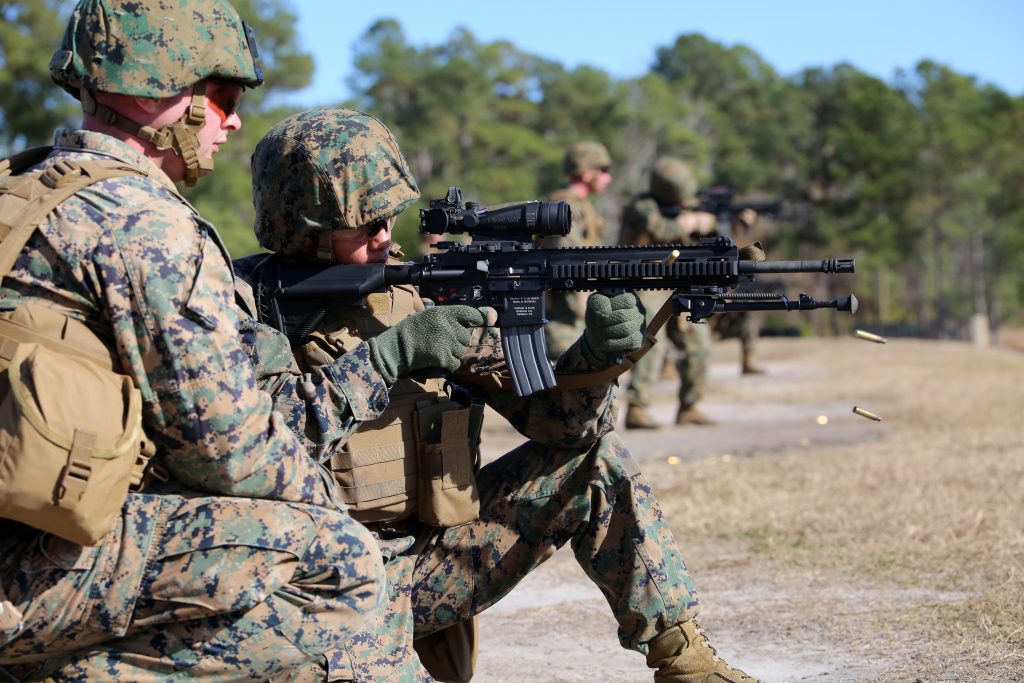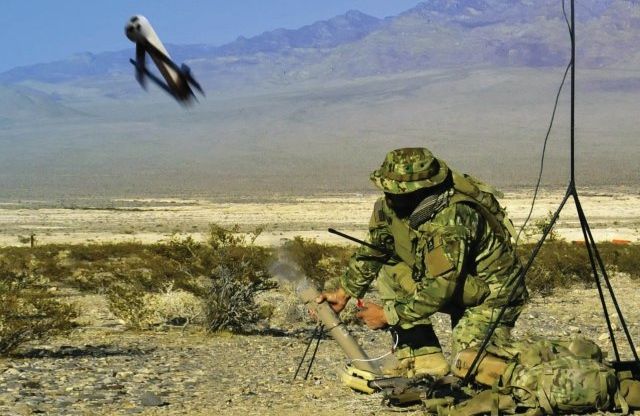By SYDNEY J. FREEDBERG JR.
 “Everything that Marine wears -- from their boots to their socks to their utilities to their helmet -- is all going to be changed," the Commandant said. "We’ve got money now to do that, and so we’ve got to make it happen now. We’ve got to make it happen now, because I’m not going to make the assumption that that money’s going to be there.” To conduct such “distributed operations,” Commandant Robert Neller said last night, the Marines are adding technical experts — in drones, intelligence, supply, and other specialties — to small units so they can operate more independently of higher headquarters. The tradeoff comes in old-fashioned firepower: Infantry squads will shrink from 13 Marines to 12, and infantry battalions will have fewer heavy-duty support weapons such as 81 mm mortars and TOW anti-tank missile launchers.
“Everything that Marine wears -- from their boots to their socks to their utilities to their helmet -- is all going to be changed," the Commandant said. "We’ve got money now to do that, and so we’ve got to make it happen now. We’ve got to make it happen now, because I’m not going to make the assumption that that money’s going to be there.” To conduct such “distributed operations,” Commandant Robert Neller said last night, the Marines are adding technical experts — in drones, intelligence, supply, and other specialties — to small units so they can operate more independently of higher headquarters. The tradeoff comes in old-fashioned firepower: Infantry squads will shrink from 13 Marines to 12, and infantry battalions will have fewer heavy-duty support weapons such as 81 mm mortars and TOW anti-tank missile launchers.
Not all the changes have been finalized, but pending a formal bulletin to the force, Neller outlined the following moves to a Marine Corps Association awards banquet:
Each rifle squad will get its own quadcopter mini-drone to scout ahead and a drone operator to run it. But the squad will shrink from 13 Marines (three fire teams of four plus a squad leader) to 12 (three fire teams of three plus a command team of squad leader, assistant squad leader, and “squad systems operator”). Every rifleman will carry the new M27 Infantry Automatic Rifle (IAR), complete with flash suppressor, instead of the lighter and less powerful M4 or M16.
Each rifle platoon will also get a specialist drone operator. They and the platoon leadership will also get the M27.
Each company headquarters will get an intelligence cell — making permanent an improvisation from Afghanistan and Iraq — as well as drone operators for reconnaissance, counter-drone specialists to defeat enemy reconnaissance, and logisticians to keep the company supplied.
Each battalion will gain a combat engineer platoon and reshuffle its weapons company. The number of anti-tank teams with shoulder-fired Javelin missiles will increase from eight to 12, and the Javelin’s range will increase with an upgraded control unit. But the number of the heavier (and older) TOW missile launchers will drop by half, from eight to four, and the number of 81 mm mortars by a quarter, from eight to six. The weapons company will also get Polaris MRZR offroad vehicles to help haul its heavy gear. Their personnel, however, will stick with the old M4 carbine.
“I felt like we could afford to get a little bit lighter,” Neller said of the weapons company changes, speaking to reporters after the dinner, “because of what I anticipate to be the increased range and lethality of weapons and because of other capabilities I think the squad platoon and company’s going to have like Switchblade.” Switchblade is a drone that can both scout for targets and dive on them, detonating itself (or you can think of it as a missile that can do reconnaissance).

Launching a Switchblade drone/missile
“There’s Risk”
Even with the current generous budgets, Neller said, tradeoffs are inevitable. “There’s risk ,” he acknowledged to reporters. “(But) remember we just added a company intel cell and a log cell….a UAV/counter-UAV team. I just added four Javelin teams (to the weapons company). I’ve got to pay for that.”
Some of these changes are already underway, said Neller, like issuing the M27. “We’ll start fielding the rifle as soon as the manufacturer can get it in their hands, and then other things are going to take longer,” he said. “Some things will be months. Some things will be longer. It’s not like we’re going to wake up tomorrow and this will all be in place.”
Marine firing M4 carbine
The M27 is basically a heavier M16, with greater firepower, longer range, and more robust mechanisms. (Specifically, it replaces the M16 family’s finicky gas impingement system with a conventional piston-based recoil). It was originally bought as the rifle squad’s high-firepower weapon, replacing the M249 SAW (Squad Automatic Weapon, essentially a light machinegun). But now Neller will issue it to every Marine in the infantry, reconnaissance, and combat engineers. The M4 carbines freed up this way will go to non-infantry troops. Eventually, Neller said of the M4, “it’s going to be the weapon that we’re going to give to everybody else because it’s a newer weapon and it’s lighter.”
The squad’s new drone operator will get the heavy-duty M27. “Right now, that Marine is still an infantryman,” Neller said. “They’re going to have to fight…They’re part of the squad,” with the same Military Occupational Specialty (MOS) as the other infantrymen.
In fact, Neller is issuing everyone in the rifle platoon the same weapon so enemy snipers can’t easily pick out, say, the drone specialist or the platoon leader. “I want everybody in the platoon to look the same. I don’t want any bad guy to go, hey this person or that person’s carrying this weapon, so shoot them first,” he said. “When I would do a battlefield circulation in Iraq (i.e. visiting frontline units), I always carried a carbine — and all my guys hoped to God I didn’t have to use it — but it was camouflage.”
There’s another tradeoff here: While the M4 carbine that became standard in Iraq and Afghanistan is significantly lighter than the M16 rifle, the M27 IAR is significantly heavier, even before you add the now-standard flash suppressor. Add mini-drones, night vision devices, laser designators, and other high-tech kit,
So when Neller talked to 3rd Battalion, 5th Marine Regiment, which experimented with a lot of the new gear now being issued Corps-wide, “their biggest concern was the same concern I had,” he said: “We’ve got too much stuff and it weighs too much. You can’t just keep loading stuff on.”
The Marines are reviewing every item that foot troops carry Neller said: “We’re going to get down to ounces.” He’s particularly optimistic about new forms of ammunition that replace metal cartridges with lightweight materials that are consumed in the act of firing, although those aren’t being fielded yet.
The changes announced last night are just the start. The Marines have a lot of technology in their long-term plans:
new long-range precision-guided missiles for the artillery, including ones capable of killing ships at sea, a project the Marines are working on with the Army;
miniaturized missile defenses for armored vehicles, called Active Protection Systems, to shoot down incoming anti-tank weapons, another joint Army-Marine effort;
a ship-launched reconnaissance drone called MUX;
a new Armored Reconnaissance Vehicle (ARV) to bring F-35-like sensor and networking capabilities to the ground force;
new anti-aircraft defenses, including a quick-start Other Transaction Authority (OTA) initiative to integrate an off-the-shelf missile with existing Marine radars and command-and-control;
more tank companies and a new HIMARS rocket artillery battalion.
There’ll be plenty of small-scale improvements as well, Neller promised the audience at the dinner, as long as the current funding lasts — which may not be long, given the looming return of Budget Control Act caps in 2020.
“Everything that Marine wears — from their boots to their socks to their utilities to their helmet — is all going to be changed,” the Commandant said. “We’ve got money now to do that, and so we’ve got to make it happen now. We’ve got to make it happen now, because I’m not going to make the assumption that that money’s going to be there.”
The original version of this article mistakenly said there would be multiple drone specialists at platoon level in the new organization. There is only one.
No comments:
Post a Comment